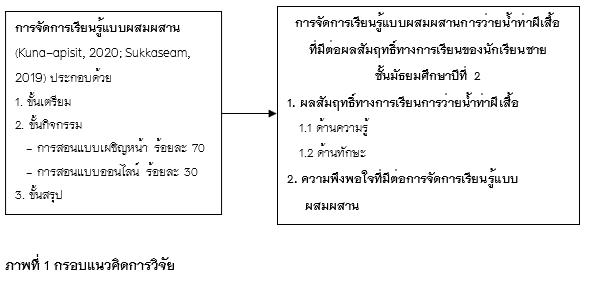ผลการจัดการเรียนรู้แบบผสมผสานการว่ายน้ำท่าผีเสื้อที่มีต่อผลสัมฤทธิ์ทางการเรียนของนักเรียนชายชั้นมัธยมศึกษาปีที่ 2
Main Article Content
บทคัดย่อ
การศึกษาครั้งนี้มีวัตถุประสงค์เพื่อ 1) ศึกษาผลการจัดการเรียนรู้แบบผสมผสานการว่ายน้ำท่าผีเสื้อที่มีต่อผลสัมฤทธิ์ทางการเรียนของนักเรียนชายชั้นมัธยมศึกษาปีที่ 2 2) เปรียบเทียบผลการจัดการเรียนรู้แบบผสมผสานการว่ายน้ำท่าผีเสื้อที่มีต่อผลสัมฤทธิ์ทางการเรียนด้านความรู้และด้านทักษะของนักเรียนชายชั้นมัธยมศึกษาปีที่ 2 ระหว่างก่อนเรียน หลังเรียนสัปดาห์ที่ 4 สัปดาห์ที่ 6 และสัปดาห์ที่ 8 และ 3) ศึกษาความพึงพอใจต่อการจัดการเรียนรู้แบบผสมผสานการว่ายน้ำท่าผีเสื้อที่มีต่อผลสัมฤทธิ์ทางการของนักเรียนชายชั้นมัธยมศึกษาปีที่ 2 กลุ่มตัวอย่างเป็นนักเรียนชายชั้นมัธยมศึกษาปีที่ 2 ภาคเรียนที่ 1 ปีการศึกษา 2565 โรงเรียนสาธิตมหาวิทยาลัยศรีนครินทรวิโรฒ ประสานมิตร (ฝ่ายมัธยม) จำนวน 30 คน ได้มาด้วยวิธีการเลือกแบบเจาะจง เครื่องมือที่ใช้ในการวิจัย ประกอบด้วย แผนการจัดการเรียนรู้แบบผสมผสาน แบบวัดความรู้และแบบประเมินทักษะว่ายน้ำท่าผีเสื้อ และแบบสอบถามความพึงพอใจต่อการจัดการเรียนรู้แบบผสมผสาน วิเคราะห์ข้อมูลโดยหาค่าเฉลี่ย ส่วนเบี่ยงเบนมาตรฐาน การวิเคราะห์ความแปรปรวนแบบทางเดียวชนิดวัดซ้ำ ทดสอบความแตกต่างรายคู่ด้วยวิธี LSD กำหนดระดับความแตกต่างนัยสำคัญทางสถิติที่ .05 และทดสอบค่าที แบบ One Sample t-test
ผลการวิจัย พบว่า 1) นักเรียนมีผลสัมฤทธิ์ทางการเรียนหลังเรียนด้วยการจัดการเรียนรู้แบบผสมผสานการว่ายน้ำท่าผีเสื้อด้านความรู้และด้านทักษะว่ายน้ำท่าผีเสื้อสูงกว่าก่อนเรียน 2) นักเรียนมีคะแนนเฉลี่ยด้านความรู้และด้านทักษะว่ายน้ำท่าผีเสื้อหลังสัปดาห์ที่ 4 สัปดาห์ที่ 6 และสัปดาห์ที่ 8 สูงกว่าก่อนเรียนอย่างมีนัยสำคัญทางสถิติที่ระดับ .05 และ 3) นักเรียนมีความพึงพอใจต่อการจัดการเรียนรู้แบบผสมผสานการว่ายน้ำท่าผีเสื้อในภาพรวมอยู่ในระดับมากที่สุดและสูงกว่าเกณฑ์ที่กำหนดอย่างมีนัยสำคัญทางสถิติที่ระดับ .05
Article Details

This work is licensed under a Creative Commons Attribution-NonCommercial-NoDerivatives 4.0 International License.
References
Fernandez, R., & Waldi, E. P. (2020). Development of online learning video for blended learning in teletraffic course. Advances in Social Science, Education and Humanities Research, 506, 215 - 218.
Feng, S. (2018). Applied research on college sports blended learning based on moodle platform. Educational Sciences: Theory & Practice, 18(5), 1077.
Juithong, S. (2022). Outcomes of the new normal online blended learning management during COVID-l9 pandemic towards student teachers’ learning abilities. Rajabhat Rambhai Barni Research Journal, 16(2), 126-134. [in Thai]
Khamwichai, K. (2023) The development of blended physical education lesson plans on hitting skills in Krabi Krabong course of lower secondary school students. Journal of Education and Human Development Sciences, 7(1), 52-68. [in Thai]
Kuna-apisit, W. (2020). Programs and physical education leaning management. (4th edition). Bangkok: School of Language and Culture Book Center. [in Thai]
Kanjanawasee, S. (2019). Research mthodology. (9th edition) Bangkok: Chulalongkorn University Press. [in Thai]
MasterClass staff. (2021). Butterfly stroke: How to swim the butterfly stroke. Retrieved from https://www.masterclass.com/articles/butterfly-stroke-guide
Ministry of Education. (2019). National Education Act of B.E. 2019. Bangkok: Ministry of Education. [in Thai]
Rahayu, T., Ali, M.A., Anggita, G.M., & Castyana, B. (2022). Blended learning for physical Education. Semarang.
Prasertsin, U. (2020). Research Instruments in education and social sciences. Bangkok: Chulalongkorn University Press. [in Thai]
Pachob, S. (2021). The effect of blended learning in Innovation and educational technology courses of students in the Faculty of Education Pitchayabundit College. Academic Journal of Mahamakut Buddhist University Roi Et Campus, 10(1), 316-326. [in Thai]
Rahayu, T., Ali, M.A., Anggita, G.M., & Castyana, B. (2022). Blended learning for physical Education. Semarang.
Rahayu, T., Ali, M.A., Koenen, K., Blume, A., Anggita, G.M., Castyana, B., & Raharjo, H.P. (2020). Blended learning as the new innovation in physical education class. Retrieved from https://www.researchgate.net/publication/346451852_Blended_Learning_as_The_New_Innovation_in_Physical_Education_Class
Srinakharinwirot University Prasarnmit Demonstration School (Secondary). (2022). Evaluation manual for learning achievement in swimming supplementary course. Bangkok: Srinakharinwirot University. [in Thai]
Sugeerakunkui, M. (2021). Effects of health education learning management using blended learning model on learning achievement and executive functions of ninth grade students. Academic Journal of Thailand National Sports University, 13(3), 249-262. [in Thai]
Swimgym. (2021). The 5 key elements of butterfly. retrieved from https://www.swimming.org/masters/advanced-butterfly-stroke-technique
Sukpom, T., Papan, N., & Techaraungrong, P. (2020). Teachers and Instructional technology in 21st century. Journal of Graduate studies, 15(2), 1-17. [in Thai]
Sukkaseam, S. (2019) Development of blended learning model in Introduction to computer Information science course for undergraduate students. Journal of Education Naresuan University, 21(4), 317-328. [in Thai]
Sports Authority of Thailand. (2015). Swimming training guide for Instructors. Bangkok: Sports Authority of Thailand. [in Thai]
Thungkanai, K. (2021). Blended learning in a new normal. Journal of Educational Studies, 15(1), 29-43. [in Thai]
Thanawon, S., & Robroo, I. (2020). Instructional design of blended learning activities using Problem-Based learning in chemistry 3 subject for upper secondary students at Sumutsakhonwittayalai school, Sumutsakhon province. Journal of Graduate School Sakonnakhon Rajabhat University, 17(79), 128-140 [in Thai]
Wang, C. (2022). Effects of blended learning in physical education among university students: A systematic review. Educational Sciences, 12(1), 9-12.

